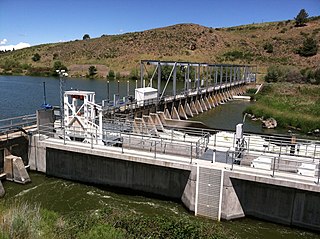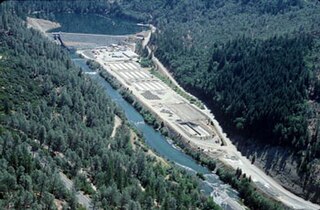
Wells Dam is a hydroelectric embankment dam located on the Columbia River, downstream from the confluence of the Okanogan River, Methow River, and the Columbia River in Washington state. The dam, associated structures, and machinery make up the Wells Hydroelectric Project. It is owned and operated by Douglas County Public Utility District.

The Link River Dam is a concrete gravity dam on the Link River in the city of Klamath Falls, Oregon, United States. It was built in 1921 by the California Oregon Power Company (COPCO), the predecessor of PacifiCorp, which continues to operate the dam. The dam is owned by the U.S. Bureau of Reclamation.

The Klamath Project is a water-management project developed by the United States Bureau of Reclamation to supply farmers with irrigation water and farmland in the Klamath Basin. The project also supplies water to the Tule Lake National Wildlife Refuge, and the Lower Klamath National Wildlife Refuge. The project was one of the first to be developed by the Reclamation Service, which later became the Bureau of Reclamation.

Isabella Dam is an embankment dam located in the Kern River Valley, about halfway down the Kern River course, between the towns of Kernville and Lake Isabella in Kern County, California.

Condit Hydroelectric Project was a development on the White Salmon River in the U.S. state of Washington. It was completed in 1913 to provide electrical power for local industry, and is listed in the National Register of Historic Places as an engineering and architecture landmark.

The Klamath Basin is the region in the U.S. states of Oregon and California drained by the Klamath River. It contains most of Klamath County and parts of Lake and Jackson counties in Oregon, and parts of Del Norte, Humboldt, Modoc, Siskiyou, and Trinity counties in California. The 15,751-square-mile (40,790 km2) drainage basin is 35% in Oregon and 65% in California. In Oregon, the watershed typically lies east of the Cascade Range, while California contains most of the river's segment that passes through the mountains. In the Oregon-far northern California segment of the river, the watershed is semi-desert at lower elevations and dry alpine in the upper elevations. In the western part of the basin, in California, however, the climate is more of temperate rainforest, and the Trinity River watershed consists of a more typical alpine climate.

Lewiston Lake is a reservoir impounded by Lewiston Dam on the Trinity River, in Trinity County, California.
Merwin Dam is a concrete arch gravity-type hydroelectric dam on the Lewis River, in the U.S. state of Washington. It is located on the border between Cowlitz County and Clark County. Its reservoir is called Lake Merwin.
Swift Dam or Swift No. 1 is an earth-type hydroelectric dam on the Lewis River, in the U.S. state of Washington. Completed 65 years ago in 1958, it is located in Skamania County and its reservoir is called Swift Reservoir.

Lucky Peak Dam is a rolled earth and gravel fill embankment dam in the western United States, located on the Boise River in southwestern Idaho. In Ada County east of Boise, it is directly downstream of Arrowrock Dam, a concrete arch dam completed in 1915. At the time of its construction in the early 1950s, Lucky Peak's primary purpose was flood control, with a secondary purpose of irrigation. The normal operating elevation of the full reservoir is 3,055 feet (931 m) above sea level, the empty reservoir's elevation is 2,824 feet (861 m).
Iron Gate Dam is an earthfill hydroelectric dam on the Klamath River in northern California, outside Hornbrook, California, opened in 1964. The dam blocks the Klamath River to create the Iron Gate Lake Reservoir. It is the lowermost of a series of power dams on the river, the Klamath River Hydroelectric Project, operated by PacifiCorp. It also poses the first barrier to migrating salmon in the Klamath. The Iron Gate Fish Hatchery was placed just after the dam, hatching salmon and steelhead that are released back into the river. The Iron Gate Dam along with the John C. Boyle Dam are two of four on the Klamath River that would be removed under the Klamath Economic Restoration Act. As of February 2016, the states of Oregon and California, the dam owners, federal regulators and other parties reached an agreement to remove all four dams by the year 2020, pending approval by the Federal Energy Regulatory Commission. As of February 25, 2022, the FERC released their final Environmental Impact Statement (EIS) on the dam's removal. The Iron Gate Dam is expected to be removed sometime in 2023 or 2024. A movement to Un-Dam the Klamath has been ongoing for 20 years to remove the dams.

Shepaug Dam is a dam located between Newtown in Fairfield County and Southbury in New Haven County, Connecticut.

Mississinewa Lake Dam is a dam in Miami County, Indiana, just outside the town of Peru, in the central part of the state.

The Mahoning Creek Dam is a dam in Armstrong County, Pennsylvania.
Swift Dam is a dam in Pondera County, Montana, on the southern end of the Blackfeet Indian Reservation.

Bear River Dam is a dam in Amador County, California, due east of Sacramento.

John C. Boyle Reservoir is an artificial impoundment behind John C. Boyle Dam on the Klamath River in the U.S. state of Oregon. The lake is 16 miles (26 km) west-southwest of Klamath Falls along Oregon Route 66.
The Klamath River Hydroelectric Project is a series of hydroelectric dams and other facilities on the mainstem of the Klamath River, in a watershed on both sides of the California/Oregon border.

Un-Dam the Klamath (#UnDamtheKlamath) is a social movement in the United States to remove the dams on the Klamath River primarily because they obstruct salmon, steelhead, and other species from accessing the upper basin which provides hundreds of miles of spawning habitat. The dams have also significantly harmed Hupa, Karuk, Klamath, and Yurok lifeways and communities. Copco #1, Copco #2, Iron Gate and J.C. Boyle are the four hydroelectric dams on the Klamath River that are being advocated for removal.














